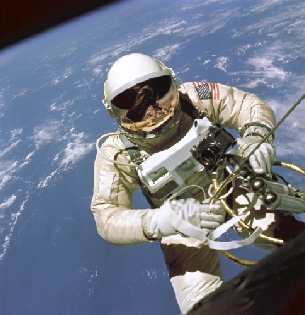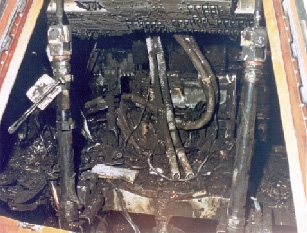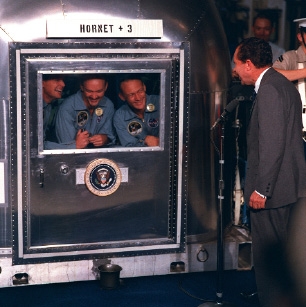

Shortly after their selection as America’s first astronauts, the Mercury Seven donned their military uniforms and posed beside one of the Corsair 106-B jet aircraft they used for proficiency flight training. The astronauts are (left—right) Navy Lt. Malcolm Scott Carpenter, Air Force Capt. Leroy Gordon Cooper Jr., Marine Lt. Col. John Herschel Glenn Jr., Air Force Capt. Virgil Ivan (Gus) Grissom, Navy Lt. Cmdr. Alan Bartlett Shepard Jr., and Air Force Capt. Donald Kent (Deke) Slayton.

The Mercury Seven training at an Air Force survival school in the Nevada desert in 1960. From left: Gordo Cooper, Scott Carpenter, John Glenn, Alan Shepard, Gus Grissom, Wally Schirra, and Deke Slayton.

On May 5, 1961, Alan Shepard became America’s first man in space as a Redstone rocket propelled him 115 miles high and 302 miles down the Atlantic tracking range. For five minutes the astronaut experienced the eerie sense of weightlessness, calling it “a wonderful feeling.” The 16-minute flight ended with Freedom Seven parachuting into the ocean. A helicopter raced to the scene, hoisted Shepard aboard, and ferried him to a nearby aircraft carrier. “Boy, what a ride!” he told the crew.

President John F. Kennedy congratulated astronaut Alan Shepard and presented him with the NASA Distinguished Service Medal during a Rose Garden ceremony at the White House three days after Shepard became the first American in space. Louise Shepard, Alan’s wife, stood at the left, with his mother. Other Mercury astronauts and government officials observed. Seventeen days later, on May 25, 1961, in a special message to Congress, Kennedy challenged the Soviets in the space arena and put the United States on a course to the moon by declaring the nation should land a man on the moon and return him safely to earth before the end of the decade.

Project Gemini followed the pioneering Mercury program and during 10 flights of the two-man spacecraft in 1965 and 1966, astronauts perfected all the techniques needed to go to the moon—rendezvous and docking, spacewalking, and long-duration flights of up to two weeks. Edward H. White II became the first American to walk in space, cavorting for 21 minutes outside while linked to the Gemini 4 with a 25-foot safety line.

Tragedy struck the U.S. space program and slowed the march to the moon when fire flashed through the Apollo 1 capsule during a routine launch pad test on January 27, 1967, killing astronauts Gus Grissom, Edward White II and Roger Chaffee. The exterior of the Apollo 1 spacecraft was charred when interior pressure burst the hull of the vehicle and spewed flames through the opening. A view of the interior revealed the effects of the intense heat. Investigators said the fire was caused by defective electrical wiring.


The Apollo 11 crew: Commander Neil Armstrong, Command Module Pilot Mike Collins, and Lunar Module Pilot Buzz Aldrin.

On July 16, 1969, Astronauts Neil Armstrong, Mike Collins, and Buzz Aldrin rocketed away from earth and four days later Armstrong and Aldrin rode the Lunar Module Eagle to a touchdown on the moon’s Sea of Tranquility while Collins stood watch in lunar orbit aboard the Command Module Columbia. Aldrin (shown here) and Armstrong were on the moon more than 21 hours and spent two hours exploring outside their lander.

President Richard M. Nixon greeted Apollo 11 astronauts Neil Armstrong, Mike Collins, and Buzz Aldrin aboard the aircraft carrier USS Hornet in the Pacific Ocean following the spacemen’s return from man’s first moon-landing mission. To protect the earth from any possible contamination, the astronauts on recovery were placed in an elaborate quarantine trailer. So the president faced the three through a glass window in their isolation van, saying “This is the greatest week in the history of the world since the creation. As a result of what you have done, the world has never been closer together.”

A major crisis developed in April 1970 when an oxygen tank exploded aboard Apollo 13—Astronauts James Lovell, Jack Swigert, and Fred Haise were 200,000 miles from earth, rapidly losing vital oxygen and other supplies, when the blast hit. The sought shelter in the undamaged Lunar Module while Mission Control perfected the means to bring them home safely. Here their spacecraft is being hoisted aboard the carrier Iwo Jima following recovery.

Alan Shepard (center), was named to command Apollo 14, flying with Stuart Roosa (left), and Ed Mitchell.

The Lunar Module Antares carried Alan Shepard and Ed Mitchell to the moon’s Fra Mauro highlands, where they made two outside excursions, in February 1971.

Sixteen years after he was named one of America’s original Mercury Seven astronauts in 1959, Deke Slayton finally realized his dream of flying in space. He teamed with astronauts Tom Stafford and Vance Brand in July 1975 as they linked their Apollo spacecraft with a Soviet Soyuz carrying cosmonauts Alexel Leonov and Valeri Kubasov—a mission that would have been considered unthinkable just a few years earlier as the two superpower rivals maneuvered for superiority in space. A symbol of high-flying détente, Slayton and Leonov cavorted in the weightlessness of the Soyuz cabin while orbiting the earth in the first international space flight.